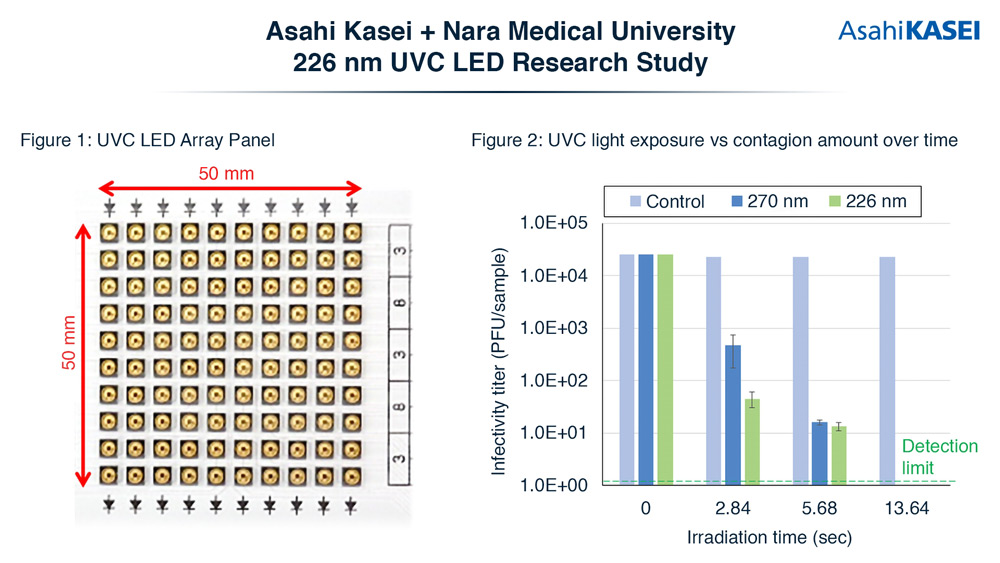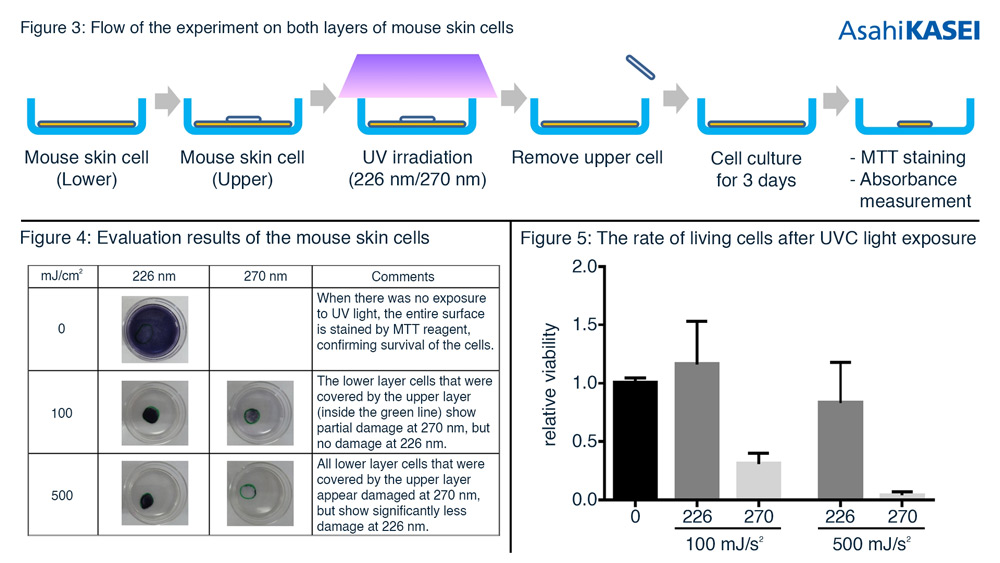News: LEDs
15 June 2021
Asahi Kasei and Nara Medical University confirm 226nm UVC LED efficacy against SARS-CoV-2
Tokyo-based Asahi Kasei has announced the results of joint research with Nara Medical University regarding the efficacy of 226nm ultraviolet-C (UVC) LEDs in the inactivation of the coronavirus (SARS-CoV-2) that causes COVID-19, and its effects on animal skin cells.
This is reckoned to be the first study in the world conducted with LEDs of this wavelength, and the results confirm that the 226nm UVC LEDs are able to quickly inactivate SARS-CoV-2 while having significantly less effect on animal skin cells than 270nm UVC LEDs.
Combating pathogens with UVC light
The inactivation (killing) of viruses and other pathogens using UV light rather than chemical disinfectants has drawn greater attention with the COVID-19 pandemic. Nevertheless, it has been necessary to prevent light from conventional mercury UV lamps (254nm) and UVC LEDs (260–280nm) from directly irradiating human skin due to the risk of harmful effects.
In contrast, UV excimer lamps with a wavelength of 222nm were introduced last year that show negligible effect on the human body. However, LEDs are more compact and allow greater flexibility in design, have less risk of breaking, and have a quicker startup time than traditional lamps, opening up new potential for smaller, safer and more responsive applications of UVC light.
Asahi Kasei company Crystal IS Inc of Green Island, NY, USA, which makes proprietary ultraviolet light-emitting diodes (UVC LEDs), has commercialized Klaran UVC LEDs in the 260–270nm wavelength range, and is now supporting research by Asahi Kasei to reach shorter wavelengths. Recently, Asahi Kasei’s corporate R&D was able to create 226nm UVC LED prototypes, and tests were conducted for these LEDs regarding their efficacy for inactivating SARS-CoV-2 (strain 2019-nCoV JPN/TY/WK-521) as well as their effects on animal skin cells.
All the biological experiments were conducted on the campus of Nara Medical University in Bio Safety Level 3 (BSL3) testing facilities under appropriate means to safely contain the active virus. Furthermore, airborne viruses or their effects on humans were not tested.
One hundred of the 226nm UVC LEDs were placed on a panel in a 10x10 array, as shown in Figure 1. For comparison, a similar array of 270nm UVC LEDs was also prepared. All of the UVC LEDs used in this study were created from the proprietary aluminium nitride (AlN) substrate and pseudomorphic aluminium gallium nitride (AlGaN) technology of Crystal IS.

226nm UVC LED efficacy for inactivating SARS-CoV-2
Liquid containing viable SARS-CoV-2 was injected into a Petri dish and then dried. Panel arrays of 226nm and 270nm UVC LEDs were activated at the same output (440μW/cm2). Afterwards, the virus was collected, and the amount of contagion was measured by the plaque technique (a method of measuring virus volumes after the degeneration of virus infected cells). The results, shown in Figure 2, indicate that, in about 6 seconds, 99.9% of the virus was inactivated by both 226nm and 270nm UVC LEDs.
Evaluating the effects on animal skin cells
An additional experiment was conducted on mouse skin cells to estimate the damage that 226nm UVC LED light has on animal skin compared with 270nm light. Figure 3 shows the flow of the experiment. The mouse skin cells were arranged in two layers which were then exposed to either 226nm or 270nm UVC LED light at a dosage of 100mJ/cm2 and 500mJ/cm2.
After the exposure, the upper layer of the cells was removed and the relative fraction of living cells in the bottom layer was evaluated by measuring the absorbance (optical density) after applying an MTT reagent dye (tetrazolium salt) to the cells on the bottom layer. The dark colored dye indicates the amount of living cells that remain.

The results shown in Figure 4 and Figure 5 indicate that the 226nm UVC LED light had little to no effect at 100mJ/cm2, and even at 500mJ/cm2 there was significantly less effect on the cells of the bottom layer compared with that of the 270nm UVC LED light.
The above results indicate that 226nm UVC LEDs can quickly inactivate SARS-CoV-2 while having significantly less effect on animal skin cells compared with the current generation of 270nm UVC LEDs for disinfection. This suggests the possibility that 226nm UVC LEDs may be safely used to disinfect hands or objects where there are people nearby.
Moving forward, further advancements in technology will be necessary before the power of the light emitted from 226nm UVC LEDs can be improved enough for commercialization. Continued R&D by Asahi Kasei is progressing to make this possible.
Crystal IS and Boston Uni demo Klaran UVC LEDs’ effective wavelength for inactivating SARS-CoV-2









